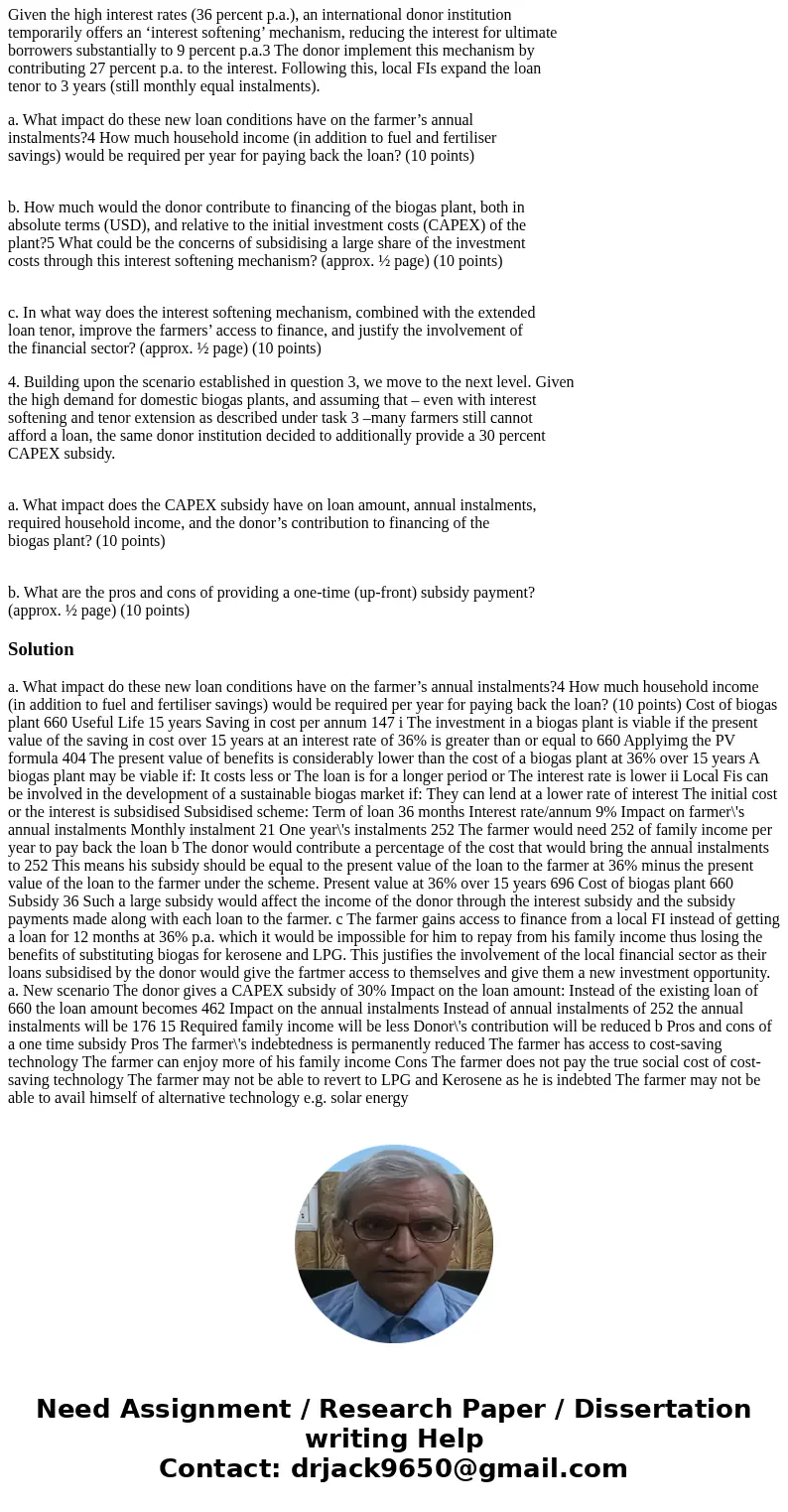Please show formulas and explanations Many farming household
Please show formulas and explanations Many farming households in the developing world use traditional biomass, kerosene and liquefied petroleum gas (LPG) for cooking and lighting. Domestic biogas – generated from the dung of farming animals – has the potential to replace other fuels for meeting basic energy needs. However, high-quality systems such as fixed-dome plants1 can be relatively expensive – especially if constructed in remote areas, where not all building materials are readily available, and where perhaps no skilled masons are located. Farmers might not have either the required capital for cash purchase, nor the required income or creditworthiness for raising – and paying back – a credit. A current debate – particularly in international development cooperation – deals with the question of how local financial institutions (FIs) can be integrated in the financing process. It is debatable, and it may differ from case to case, if lending for biogas is a viable business (and FIs have not yet realised the market potential), or if the lending potential is limited and an involvement of the private financial sector is rather more wishful thinking than a realistic option. There have been several attempts for introducing local FIs to biogas finance. Besides technical assistance (such as trainings, capacity building, business development support), different financial support mechanisms have been considered for making the investment affordable for the farmer, and for introducing local FIs to biogas lending. This assignment should assess if and under which conditions i) a biogas plant is a financially viable investment; ii) local FIs can be involved in the development of a sustainable biogas market.
BASIC ASSUMPTIONS • A 6m3 fixed-dome biogas plant (size for a small farmer family) costs 660 USD, and has a 15 year economic life-time; • By using biogas instead of kerosene and LPG, and by using the resulting bio-slurry to replace chemical fertiliser for agricultural needs, a farmer can save on average 147 USD p.a. (given fixed prices); • Interest rates for annuity loans under 1,000 USD are 36 percent p.a. (monthly equal instalments); the loan tenor is 12 months.
Given the high interest rates (36 percent p.a.), an international donor institution
temporarily offers an ‘interest softening’ mechanism, reducing the interest for ultimate
borrowers substantially to 9 percent p.a.3 The donor implement this mechanism by
contributing 27 percent p.a. to the interest. Following this, local FIs expand the loan
tenor to 3 years (still monthly equal instalments).
a. What impact do these new loan conditions have on the farmer’s annual
instalments?4 How much household income (in addition to fuel and fertiliser
savings) would be required per year for paying back the loan? (10 points)
b. How much would the donor contribute to financing of the biogas plant, both in
absolute terms (USD), and relative to the initial investment costs (CAPEX) of the
plant?5 What could be the concerns of subsidising a large share of the investment
costs through this interest softening mechanism? (approx. ½ page) (10 points)
c. In what way does the interest softening mechanism, combined with the extended
loan tenor, improve the farmers’ access to finance, and justify the involvement of
the financial sector? (approx. ½ page) (10 points)
4. Building upon the scenario established in question 3, we move to the next level. Given
the high demand for domestic biogas plants, and assuming that – even with interest
softening and tenor extension as described under task 3 –many farmers still cannot
afford a loan, the same donor institution decided to additionally provide a 30 percent
CAPEX subsidy.
a. What impact does the CAPEX subsidy have on loan amount, annual instalments,
required household income, and the donor’s contribution to financing of the
biogas plant? (10 points)
b. What are the pros and cons of providing a one-time (up-front) subsidy payment?
(approx. ½ page) (10 points)
Solution
a. What impact do these new loan conditions have on the farmer’s annual instalments?4 How much household income (in addition to fuel and fertiliser savings) would be required per year for paying back the loan? (10 points) Cost of biogas plant 660 Useful Life 15 years Saving in cost per annum 147 i The investment in a biogas plant is viable if the present value of the saving in cost over 15 years at an interest rate of 36% is greater than or equal to 660 Applyimg the PV formula 404 The present value of benefits is considerably lower than the cost of a biogas plant at 36% over 15 years A biogas plant may be viable if: It costs less or The loan is for a longer period or The interest rate is lower ii Local Fis can be involved in the development of a sustainable biogas market if: They can lend at a lower rate of interest The initial cost or the interest is subsidised Subsidised scheme: Term of loan 36 months Interest rate/annum 9% Impact on farmer\'s annual instalments Monthly instalment 21 One year\'s instalments 252 The farmer would need 252 of family income per year to pay back the loan b The donor would contribute a percentage of the cost that would bring the annual instalments to 252 This means his subsidy should be equal to the present value of the loan to the farmer at 36% minus the present value of the loan to the farmer under the scheme. Present value at 36% over 15 years 696 Cost of biogas plant 660 Subsidy 36 Such a large subsidy would affect the income of the donor through the interest subsidy and the subsidy payments made along with each loan to the farmer. c The farmer gains access to finance from a local FI instead of getting a loan for 12 months at 36% p.a. which it would be impossible for him to repay from his family income thus losing the benefits of substituting biogas for kerosene and LPG. This justifies the involvement of the local financial sector as their loans subsidised by the donor would give the fartmer access to themselves and give them a new investment opportunity. a. New scenario The donor gives a CAPEX subsidy of 30% Impact on the loan amount: Instead of the existing loan of 660 the loan amount becomes 462 Impact on the annual instalments Instead of annual instalments of 252 the annual instalments will be 176 15 Required family income will be less Donor\'s contribution will be reduced b Pros and cons of a one time subsidy Pros The farmer\'s indebtedness is permanently reduced The farmer has access to cost-saving technology The farmer can enjoy more of his family income Cons The farmer does not pay the true social cost of cost-saving technology The farmer may not be able to revert to LPG and Kerosene as he is indebted The farmer may not be able to avail himself of alternative technology e.g. solar energy

 Homework Sourse
Homework Sourse